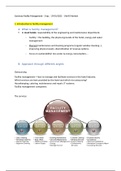Summary Facility Management – 3 stp. – 29/01/2021 – 14u45 Marriott
1. Introduction to facility management
A. What is facility management?
In most hotels: responsibility of the engineering and maintenance department.
- Facility = the building, the physical grounds of the hotel, energy and water
management.
- Planned maintenance and cleaning programs (regular window cleaning…),
improving physical assets, diversification of revenue options.
- Focus on sustainability! less water & energy consumption,…
B. Approach through different angles
Outsourcing
Facility management = how to manage and facilitate services in the hotel industry.
Which services are best provided by the hotel and which via outsourcing?
Housekeeping, catering, maintenance and repair, IT systems;
Facility management companies.
The services
,2. The role, cost and management of hospitality facilities
8 roles of facilities in the hospitality industry
Guest satisfaction
Appealing visual environment: overall ambiance, experience, comfort sustained by the maintenance
and housekeeping staff.
Facilities as the attraction
Engagement and entertainment (destination resorts, theme restaurants, casinos, theme parks).
Betrokkenheid en vermaak (bestemmingsresorts, themarestaurants, casino's, themaparken).
Unseen facilities
comfortable thermal environments, controlling indoor air conditions, water temperature;
elimination of unwanted sounds.
Manufacturing plant
equipment and systems that allow the operation to function (power and communication cabling,
elevators, collection of utilities, etc.);workplace for the employees.
Identity
maintaining characteristic roof shapes, signage, colors, trademark elements to uplift brand
knowledge & recognition
Return on investment
location where the business generates operating profit;
change in market value of the property.
Revenue generation
guest rooms, meeting spaces, dining outlets, recreation spaces;
maintain the facilities you have! (cost effective and more efficient).
Maintenance, energy, environmental and capital project expenditures are not only costs! They
contribute to guest satisfaction, employee productivity, revenues and profits.
,Facility management companies (=external, outsourcing)
ISS & EW Facility Services
Activities: housekeeping, grounds and physical plant (building) management.
Services for hospitality companies, schools, universities, etc.
Costs associated with hospitality facilities
Development and construction costs
initial costs (=first costs in the development stage):
difference between budget & economy lodging <-> convention-, resort- and luxury
properties
The number of facilities and F&B outlets in a property change depending on the type:
Budget & economy properties will have smaller investments for facility construction than a
large luxury property because they will have less facilities. -> ROI !
Operation costs (7-9% of total revenue)
- Property operation and maintenance (POM)
- labour and fringe benefit costs, maintenance supplies and
expendables, contract maintenance costs;
- correlates with initial construction costs.
- Utilities
- electricity, fuel, steam, water.
- Utilities costs depend on the occupancy !
Maintenance should be done in periods of lower occupancy.
Hard to compare two properties based on costs on a per-room basis
-hotels with vs. without banquet business;
-hotels with vs. without on-side laundry;
- !! ages of the facilities, types of building systems, local utility rates, local labour
rates, identifiable differences in construction. -> influence costs
better option: cost-per-square-foot basis instead of per-room basis
Renovation and modernization costs (0-30% of total revenue)
capital expenditures (CapEx) -> replacement of worn-out furniture, cover of wear &
tear, life safety requirements, franchise product demands, changing technology and
market demand,… -> very complex -> Planning and managing Capex is a significant
portion of the facilities manager’s duties
, The impact of facility design on facility management
facility components maintenance, renovation and operation;
problems caused by low quality materials higher maintenance costs;
low quality of construction higher construction costs;
type of construction can affect the costs of the physical plant (wood-frame
structures, exterior surface that requires painting, poorly insulated walls and roofs
etc.).
Example = a cheaper roof may be less expensive to install but will cost more in the
long run because it will have to be maintained and repaired more frequently than a
good quality roof. = more costs
Facility managers should opt for proper capital investments! (find balance, not cheap
but not too expensive)
Equipment concerns that will affect maintenance
Durability & lifetime: opt for equipment that will last longer
Repairability: make sure parts to repair it are available in your region
Efficiency: ecologically responsible decisions (led light instead of light bulb,…)
Accessibility: placement, easy access to repair the equipment
Management’s responsibilities
- Budgetary responsibility for utility, POM and CapEx;
- Safety and security
- fire protection systems;
- water purification systems
- locking systems;
- Legal compliance
- attention to local building codes;
- health department regulations;
- emissions;
- environmental requirements (e.g. recycling)
- Service
- service to guests, other departments and the owner of the building;
- properly operating equipment efficiency in housekeeping, food service
and laundry -> guest satisfaction
- Cost control
utilities (fuel, electricity, water);
maintenance and operations (labour, materials and contracts);
capital expenditures (furniture, fixtures, equipment);
- Asset management
processes of maintenance and repair;
development of the capital plans for the facility.




